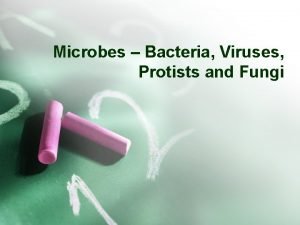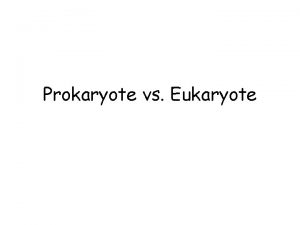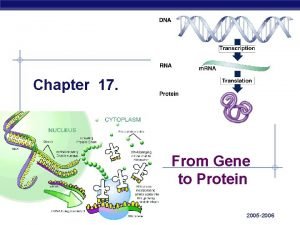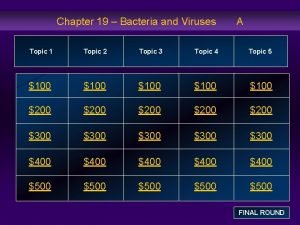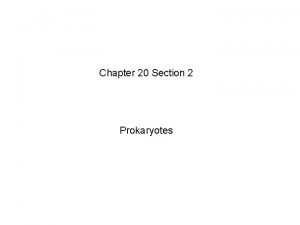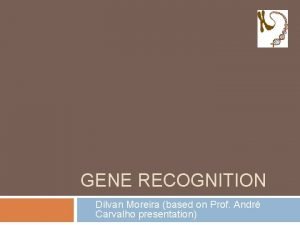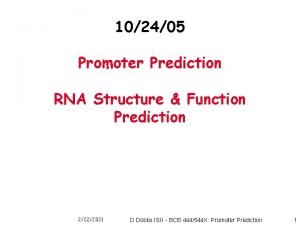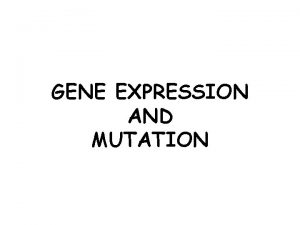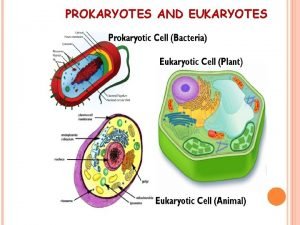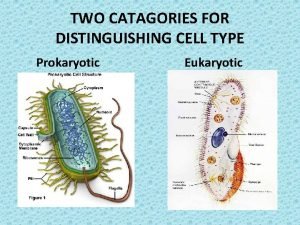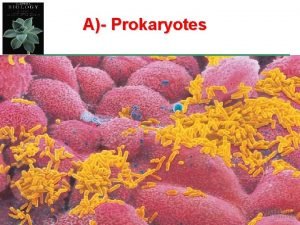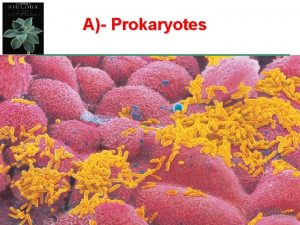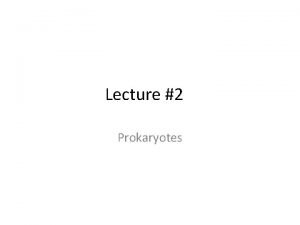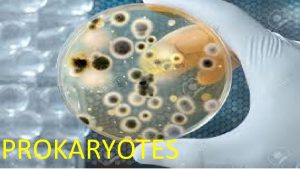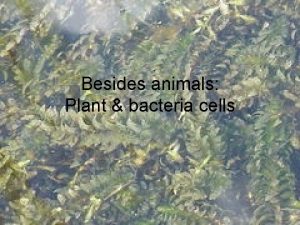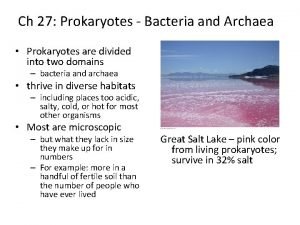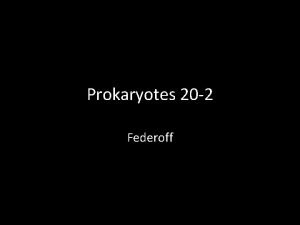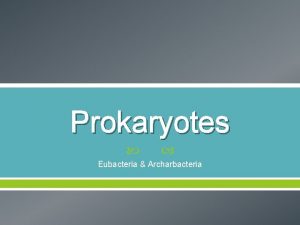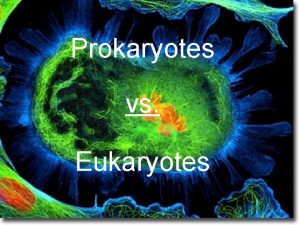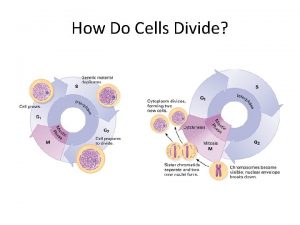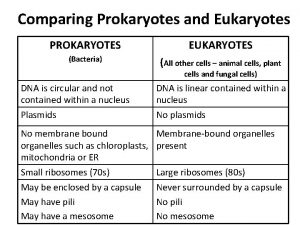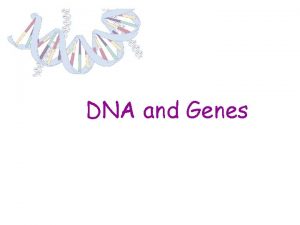A Prokaryotes What are Prokaryotes l It includes


















- Slides: 18

A)- Prokaryotes

What are Prokaryotes? l It includes two Major Domains: Archaea and Bacteria l Prokaryotes are single-celled organisms that do not have a membrane-bound nucleus, and can live in nearly every environment on Earth. l Although tiny, prokaryotes differ greatly in their genetic traits, their modes of nutrition, however, their habitats are similar. l Based on genetic differences, prokaryotes are grouped in two domains: Domain Archaea and Domain Bacteria.

1. Domain: Archaea l Archaea are extremophiles, “ ﺣﺐ ﻟﻠﻈﺮﻭﻑ ”ﺍﻟﻘﺎﺳﻴﺔ of extreme environments and can be classified into: a)- Extreme halophiles ﺣﺐ ﻟﻠﻤﻠﻮﺣﺔ : l live in such saline places as the Great Salt Lake and the Dead Sea. l Some species require an extremely salty ﺷﺪﻳﺪﺓ ﺍﻟﻤﻠﻮﺣﺔ environment to grow. b)- Extreme thermophiles ﺣﺐ ﻟﻠﺤﺮﺍﺭﺓ live in hot environments. l The optimum temperatures for most thermophiles are 60 - 80°C.

2. Domain: Bacteria occur in many shapes and sizes. Bacteria of four shapes: rodshaped, sphere-shaped, spiral-shaped, or filamentous-shaped. ﺍﻷﻬﺪﺍﺏ ﺷﺒﻪ ﻧﻮﺍﺓ ﺍﻟﺮﻳﺒﻮﺯﻭﻣﺎﺕ ﻏﺸﺎﺀ ﺑﻼﺯﻣﻰ ﺍﻟﺠﺪﺍﺭ ﺍﻟﺨﻠﻮﻯ ﺍﻟﻜﺒﺴﻮﻟﺔ ﺍﻷﺴﻮﺍﻁ

Prokaryotic Cell Plasma membrane Ribosomes Nucleoid Cell Wall Cytoplasm (Cytosol) Capsule

Shapes of Bacteria l l Bacteria occur in many shapes and sizes. Most bacteria have one of three basic shapes: rod-shaped, sphere-shaped, or spiral-shaped. Spiral shaped bacteria in the form of spirilla (singular, spirillum) or vibrio (comma like). Sphere-shaped bacteria are called cocci (singular, coccus). An example of cocci is Micrococcus luteus. Cocci are single or aggregate cells in different shapes. Rod-shaped bacteria are called bacilli (singular, bacillus). An example of bacilli is Escherichia coli. Bacilli are single or aggregate cells in different shapes also.

The Gram’s stain: ﺻﺒﻐﺔ ﺟﺮﺍﻡ l l l It is a tool for identifying ﺗﻌﺮﻳﻒ bacteria, based on differences in their cell walls. A)- Gram-positive (Gram +ve) bacteria: Their cell walls have large amounts ﻛﻤﻴﺔ ﻛﺒﻴﺮﺓ of peptidoglycans that react with Gram’s stain (appear violet-stained )ﺗﺻﺒﻎ ﺑﻨﻔﺴﺠﻴﺎ.

The Gram’s stain: ﺻﺒﻐﺔ ﺟﺮﺍﻡ l B)- Gram-negative (Gram -ve) bacteria: l their cell walls have no or small amount of peptidoglycan. So, do not react or very weakly react with Gram’s stain (appear red-stained )ﺗﺼﺒﻎ ﺑﺎﻷﺤﻤﺮ

The Gram’s stain: ﺻﺒﻐﺔ ﺟﺮﺍﻡ l Gram Stain l Most species of bacteria are classified into two categories based on the structure of their cell walls as determined by a technique called the Gram stain. l Gram-positive bacteria have a thick layer of peptidoglycan in their cell wall, and they appear violet under a microscope after the Gram-staining procedure. l Gram-negative bacteria have a thin layer of peptidoglycan in their cell wall, and they appear reddishpink under a microscope after the Gram-staining procedure.

Gram Staining of Bacteria l Gram +ve bacteria: have Large amount of peptidoglycan that stained violet. l Gram –ve bacteria: Have small amount or no peptidoglycan stained red. l Most Gram-negative species are pathogenic ( ) ﻣﻤﺮﺿﺔ more threatening ( )ﺃﻜﺜﺮ ﺧﻄﻮﺭﺓ than gram-positive species. l Gram-negative bacteria are commonly more resistant ( )ﺃﻜﺜﺮ ﻣﻤﺎﻧﻌﺔ than gram-positive species to antibiotics ﻟﻠﻤﻀﺎﺩﺍﺕ ﺍﻟﺤﻴﻮﻳﺔ.

I - the bacterial capsule l l Many prokaryotes (bacteria) secrete a sticky protective layer called capsule outside the cell wall. Capsule has the following functions ﻭﻇﺎﺋﻒ : 1. 2. 3. 4. Adhere ﺗﺜﺒﻴﺖ bacterial cells to their substratum ﺍﻟﺴﻄﺢ. Increase bacterial resistance ﺍﻟﻤﻘﺎﻭﻣﺔ to host defenses ﻣﻨﺎﻋﺔ ﺍﻟﻌﺎﺋﻞ. Stick ( )ﺗﻠﺼﻖ bacterial cells together when live in colonies. Protect ﺗﺤﻤﻰ bacterial cell.

II - The bacterial cell wall l In all prokaryotes, the functions of the cell wall are as following: 1. maintains ﺗﺤﺎﻓﻆ the shape of the cell, 2. affords physical protection ﺗﻮﻓﺮ ﺍﻟﺤﻤﺎﻳﺔ ﺍﻟﻄﺒﻴﻌﻴﺔ 3. prevents the cell from bursting ( )ﺇﻧﻔﺠﺎﺭ in a hypotonic environment ﺍﻟﺒﻴﺌﺔ ﺫﺍﺕ ﺍﻟﺘﺮﻛﻴﺰ ﺍﻷﺴﻤﻮﺯﻯ ﺍﻟﻤﻨﺨﻔﺾ. l Most bacterial cell walls contain peptidoglycan (a polymer of modified sugars cross-linked by short polypeptides). l The walls of Archaea lack ( )ﺗـﻔـﺘـﻘـﺪ peptidoglycan.

Structural Characteristics of a Bacterial Cell

Reproduction of Bacteria ﺍﻟﺘﻜﺎﺛﺮ ﻓﻲ ﺍﻟﺒﻜﺘﺮﻳﺎ l Prokaryotes reproduce ( )ﺗـﺘـﻜﺎﺛﺮ only asexually ( )ﻻ ﺟﻨﺴﻴﺎ by binary fission ( )ﺍﻹﻧﻘﺴـﺎﻡ ﺍﻟﺜـﻨﺎﺋﻲ ﺍﻟﺒﺴﻴﻂ. l A single cell produces a colony of offspring.

Nutrition of Prokaryotes ﺍﻟﺘﻐﺬﻳﺔ ﻓﻲ ﺑﺪﺍﺋﻴﺎﺕ ﺍﻟﻨﻮﺍﺓ l Nutrition refers to how an organism obtains energy and a carbon source from the environment to build the organic molecules of its cells. • Prokaryotes are grouped ( )ﻓﺕ into four categories ( )ﺃﻨﻮﺍﻉ according to how they obtain energy and carbon

Nutrition of Prokaryotes ﺍﻟﺘﻐﺬﻳﺔ ﻓﻰ ﺑﺪﺍﺋﻴﺎﺕ ﺍﻟﻨﻮﺍﺓ l Phototrophs ( )ﺿﻮﺋﻴﺔ ﺍﻟﺘﻐﺬﻳﺔ : l Chemotrophs ( )ﻛﻴﻤﻴﺎﺋﻴﺔ ﺍﻟﺘﻐﺬﻳﺔ : Organisms that obtain energy from light. Organisms that obtain energy from chemicals in their environment. l Autotrophs ( )ﺫﺍﺗﻴﺔ ﺍﻟﺘﻐﺬﻳﺔ : l Heterotrophs ( )ﻣﺘﻌﺪﺩ ﺍﻟﺘﻐﺬﻳﺔ : a carbon source. Organisms that use CO 2 as a carbon source. Organisms that use organic nutrients as

There are four major modes of nutrition v Photoautotrophs ( )ﺫﺍﺗﻴﺔ ﺍﻟﺘﻐﺬﻳﺔ ﺍﻟﻀﻮﺋﻴﺔ : use light energy as an energy source, and CO 2 as a carbon source to synthesize ( )ﺗﺨﻠﻖ organic compounds. v Chemoautotrophs ( )ﺫﺍﺗﻴﺔ ﺍﻟﺘﻐﺬﻳﺔ ﺍﻟﻜﻴﻤﻴﺎﺋﻴﺔ : use chemical inorganic substances as an energy source, and CO 2 as a carbon source. v Photoheterotrophs ( )ﻣﺘﻌﺪﺩ ﺍﻟﺘﻐﺬﻳﺔ ﺍﻟﻀﻮﺋﻴﺔ : use light as an energy source, and organic substances as carbon sources. v Chemoheterotrophs ( )ﻣﺘﻌﺪﺩ ﺍﻟﺘﻐﺬﻳﺔ ﺍﻟﻜﻴﻤﻴﺎﺋﻴﺔ : use organic substances as a source for both energy and carbon.

Prokaryotic modes of nutrition Based on Carbon source and Energy source that can be used by a prokaryotic organism to synthesize organic compounds. Prokaryotes Autotrophs CO 2 as Carbon Source Heterotrophs Organic compounds as Carbon Source Photoautotroph Chemoautotroph Photo. Heterotroph - Light as energy source - Chemicals as energy source -CO 2 as C source -Organic compounds as C source - Organic compounds as C source Chemo. Heterotroph
 Antigentest åre
Antigentest åre Which kingdoms include only prokaryotes
Which kingdoms include only prokaryotes Are fungi prokaryotes
Are fungi prokaryotes Prokaryotes vs eukaryotes
Prokaryotes vs eukaryotes Transcription in prokaryotes
Transcription in prokaryotes Chapter 20 viruses and prokaryotes
Chapter 20 viruses and prokaryotes Repressible operon
Repressible operon Some prokaryotes are able to survive unfavorable
Some prokaryotes are able to survive unfavorable Lesson 2: prokaryotes: 1
Lesson 2: prokaryotes: 1 Prokaryotes and eukaryotes
Prokaryotes and eukaryotes Gene prediction in prokaryotes and eukaryotes
Gene prediction in prokaryotes and eukaryotes Translation prokaryotes
Translation prokaryotes Diff between prokaryotes and eukaryotes
Diff between prokaryotes and eukaryotes Cytoskeletal protein
Cytoskeletal protein What is eukaryotic and prokaryotic
What is eukaryotic and prokaryotic Prokaryotic cells vs eukaryotic cells venn diagram
Prokaryotic cells vs eukaryotic cells venn diagram Lysosome location
Lysosome location Prokaryotes are classified into
Prokaryotes are classified into Clustal omega symbols
Clustal omega symbols


